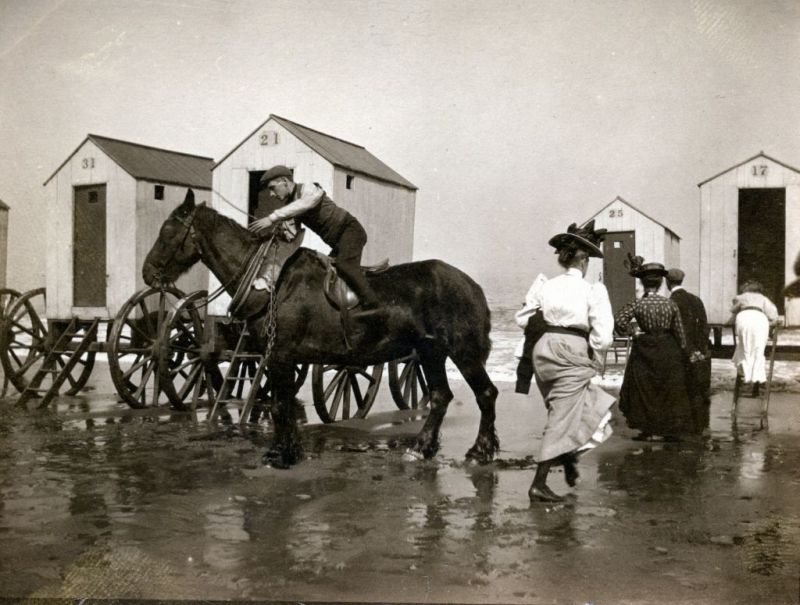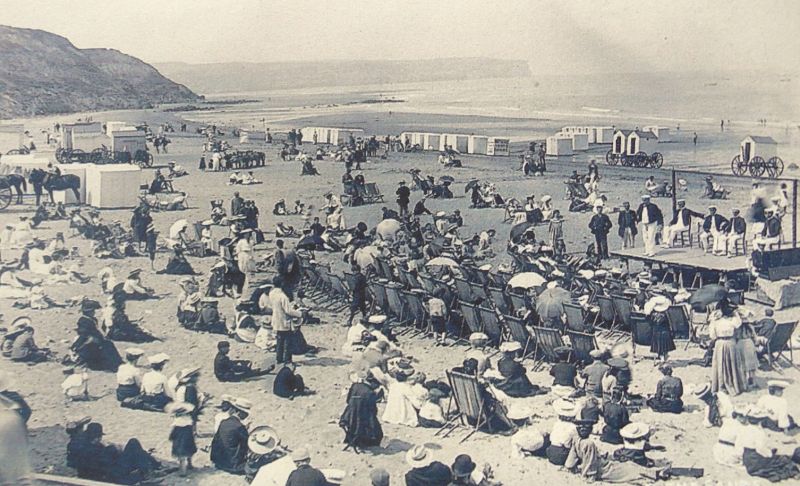ikfoundation.org
The IK Foundation
Promoting Natural & Cultural History
Since 1988


WHITBY AS A SEASIDE RESORT
in the Edwardian Period
Whitby had been a popular seaside destination for many years in the early 20th century, assisted by advertisements in the local paper from the mid-1850s where drapers, dressmakers, milliners and haberdashers tried to sell suitable clothes and accessories for the seaside tourist. However, the Edwardian era gives us more examples of holiday photography in the local area together with a wide range of guidebooks – often including adverts suited for the visitor. The aim of this historical essay is to share a selection of images from the archives of Whitby Museum, depicting seaside pastimes on the beach and the town’s West Cliff area.
This lovely snapshot depicts clothes in great detail since the women were on their way to and from the bathing machines, which made it possible for even Edwardian ladies to cool off respectably in the sea. A bathing costume can even be imagined under the arm of the lady nearest the camera; a white underskirt peeps out from under her raised skirt, as do the black stockings in her comfortable shoes. The image also shows clearly how much work was needed to move the bathing huts backwards and forwards with the help of horses to keep pace with the ebb and flow of the tide. It can also be noted that one of these selected photographs is dated 1905, so the other four are possibly from the same summer, judging by the clothes.
Seaside photography has the advantage that it often allows a more relaxed atmosphere without strict arrangement, so that it conveys a more natural impression to the viewer than contemporary studio portraits. As the number of visiting holiday-makers increased over the years, a need for entertainment of various kinds also developed, as shown in this “concert party photograph” from 1905 shows. A performance of this kind lasted an hour, for which it was possible to hire a deckchair for sixpence or throw oneself down on the sand to enjoy a warm summer day. The many big hats, white blouses, belted waists, simple long skirts and white parasols of the women were typical seaside fashion at the time.
To enjoy a day on the shore as a bystander dressed in a delicate white cotton dress was, however, mostly possible for the well-off and middle classes, judging by this and other similar photographs. Even if more extensive groups of the society were in the position to enjoy a summer Sunday at the beach in late Victorian and Edwardian times than in earlier years, those who sewed, sold fabric and clothes and washed these delicate garments seldom appeared in these photographs taken on the shore, round the Pavilion or walking in the West Cliff area.
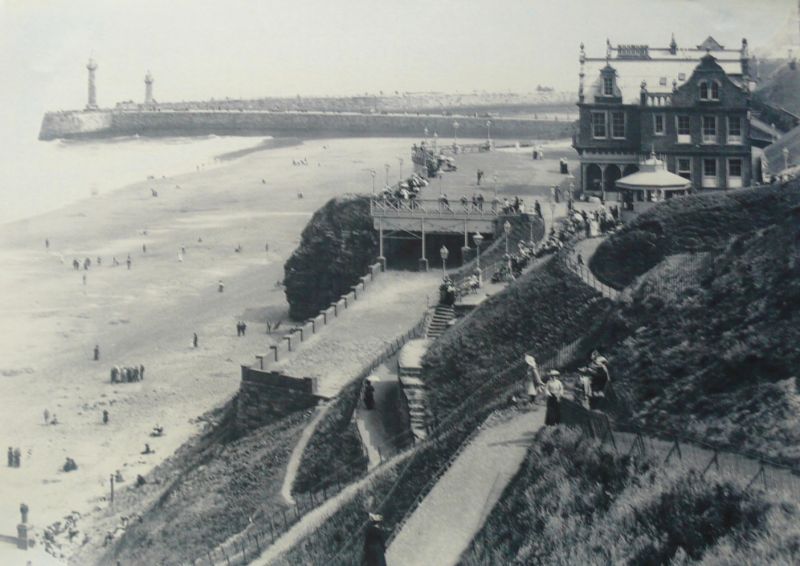 The west side beach with the cliffs, Pavilion and Whitby piers. (Courtesy of: Whitby Museum, Photographic Collection, unknown photographer).
The west side beach with the cliffs, Pavilion and Whitby piers. (Courtesy of: Whitby Museum, Photographic Collection, unknown photographer).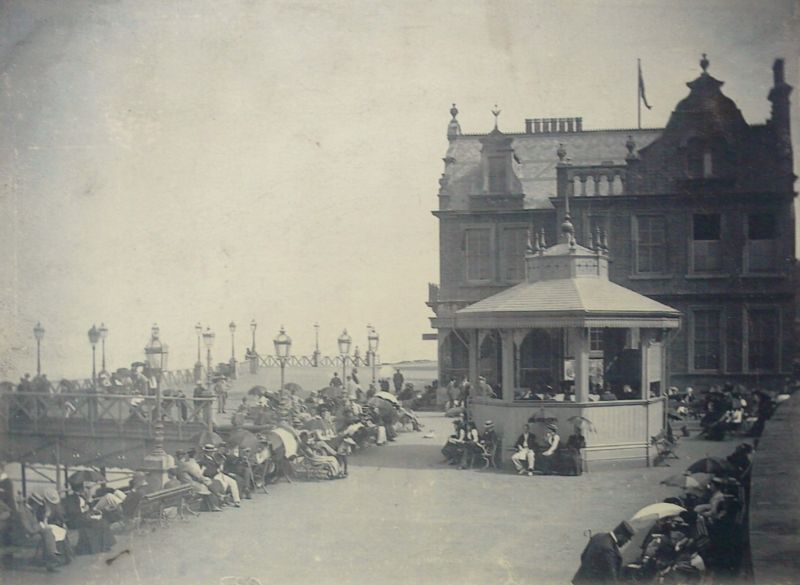 The Pavilion, built in the 1870s on the cliff side, was a popular area for entertainment and relaxing on a warm summer’s day. (Courtesy of: Whitby Museum, Photographic Collection, unknown photographer).
The Pavilion, built in the 1870s on the cliff side, was a popular area for entertainment and relaxing on a warm summer’s day. (Courtesy of: Whitby Museum, Photographic Collection, unknown photographer).Amateur photography was already introduced in the 1890s with small, easily operated hand-held cameras, but professionally produced photographs with the use of large cameras were still very much in demand up to the beginning of the First World War. It was also popular to buy professionally made postcards from the seaside resort, sometimes with coloured details. Guidebooks were another type of memorabilia, both useful during and after the holiday. Horne’s Guide to Whitby from 1897 additionally includes many examples of advertising by local drapers, where, amongst others, James N. Clarkson & Son address themselves above all to the modern tourist, offering clothes suitable ‘For Seaside, Travelling, Yachting, Cycling, and Golfing…’
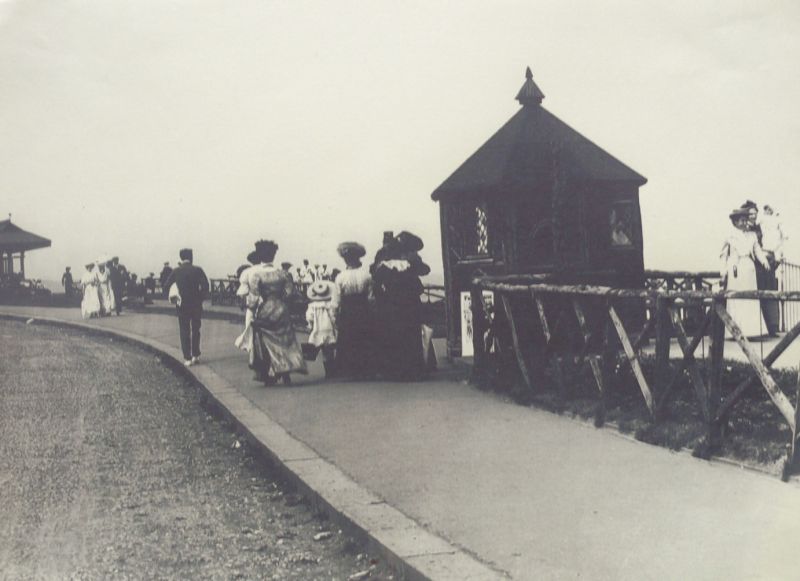 On the top of the beach at the West Cliff side of Whitby stretches this promenade with a sea view, conveniently situated close to the many hotels and guest houses. (Courtesy of: Whitby Museum, Photographic Collection, unknown photographer).
On the top of the beach at the West Cliff side of Whitby stretches this promenade with a sea view, conveniently situated close to the many hotels and guest houses. (Courtesy of: Whitby Museum, Photographic Collection, unknown photographer).Sources:
- Hansen, Viveka, The Textile History of Whitby 1700-1914, Whitby & London 2015 (research material, pre-publishing, Ch. I).
- Horne’s Guide to Whitby, Whitby 1897.
- Whitby Museum, Photographic Collection (Whitby Lit. & Phil. Society).
Essays
The iTEXTILIS is a division of The IK Workshop Society – a global and unique forum for all those interested in Natural & Cultural History from a textile Perspective.
Open Access essays, licensed under Creative Commons and freely accessible, by Textile historian Viveka Hansen, aim to integrate her current research, printed monographs, and earlier projects dating back to the late 1980s. Some essays feature rare archive material originally published in other languages, now available in English for the first time, revealing aspects of history that were previously little known outside northern European countries. Her work also explores various topics, including the textile trade, material culture, cloth manufacturing, fashion, natural dyeing, and the intriguing world of early travelling naturalists – such as the "Linnaean network" – viewed through a global historical lens.
For regular updates and to fully utilise iTEXTILIS' features, we recommend subscribing to our newsletter, iMESSENGER.
been copied to your clipboard




– a truly European organisation since 1988
Legal issues | Forget me | and much more...
You are welcome to use the information and knowledge from
The IK Workshop Society, as long as you follow a few simple rules.
LEARN MORE & I AGREE


